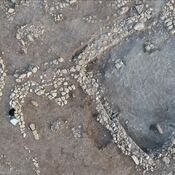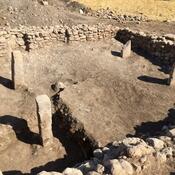Er zijn nog geen Nederlandstalige annotaties. Hier volgen annotaties in het Engels.
Ilısu Höyük (Mardin)
Ilısu Höyük situated in the Dargeçit district of Mardin provides much more
information about the Roman and Sasanian presence in the region. The excavations at
Ilısu Höyük have been conducted by Dr. Tuba Ökse from Kocaeli University since 2009.
Architectural elements of the site comprise a building surrounded by several other
buildings including hearths and cooking ovens (tandır) inside them (Ökse, 2013: 148).
On the northern side of the mound a Late Roman settlement was found. The settlement
consists of regular planned buildings with square and rectangular rooms with stone
foundation walls and is surrounded with walls including circular towers (Figures 64-65)
(Ökse, 2013: 148). The reddish earth colour and burnt mud-brick traces in some
buildings indicate that the settlement was abandoned after a fire (Ökse, 2013: 148).
Among the outstanding findings of Ilısı Höyük perhaps the most remarkable ones are
two parade masks (one of iron and one of bronze) as yet unpublished but dated to the
late second or third century which were used in military games by the soldiers (Figures
66). Regarding the location of the site, and the mask finds, one can presumes that the
site was occupied by the Roman military to control the Tigris Valley between the second
and third century (Ökse, 2013: 143).
Source: https://pdfs.semanticscholar.org/54f9/39d20f66b19fe4397d4824d401d457deb9ae.pdf
Ilısu Höyük (Mardin)
Ilısu Höyük situated in the Dargeçit district of Mardin provides much more
information about the Roman and Sasanian presence in the region. The excavations at
Ilısu Höyük have been conducted by Dr. Tuba Ökse from Kocaeli University since 2009.
Architectural elements of the site comprise a building surrounded by several other
buildings including hearths and cooking ovens (tandır) inside them (Ökse, 2013: 148).
On the northern side of the mound a Late Roman settlement was found. The settlement
consists of regular planned buildings with square and rectangular rooms with stone
foundation walls and is surrounded with walls including circular towers (Figures 64-65)
(Ökse, 2013: 148). The reddish earth colour and burnt mud-brick traces in some
buildings indicate that the settlement was abandoned after a fire (Ökse, 2013: 148).
Among the outstanding findings of Ilısı Höyük perhaps the most remarkable ones are
two parade masks (one of iron and one of bronze) as yet unpublished but dated to the
late second or third century which were used in military games by the soldiers (Figures
66). Regarding the location of the site, and the mask finds, one can presumes that the
site was occupied by the Roman military to control the Tigris Valley between the second
and third century (Ökse, 2013: 143).
Source: https://pdfs.semanticscholar.org/54f9/39d20f66b19fe4397d4824d401d457deb9ae.pdf






